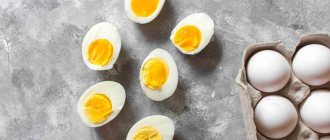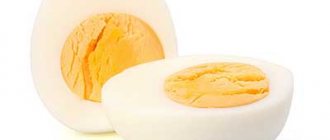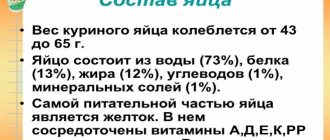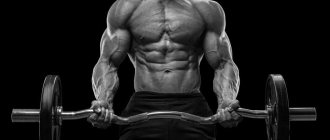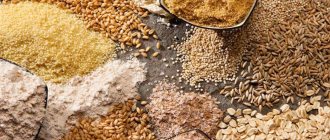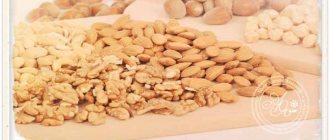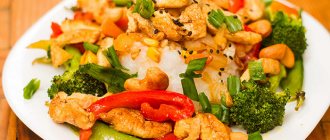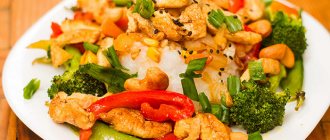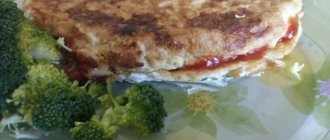How does a chicken egg work?
This is a useful and popular product because it includes a full set of essential amino acids, vitamins, and mineral compounds. Its structure is as follows:
- Shell. It is durable, but has pores for the exchange of air and moisture with the environment. Its thickness is from 0.3 to 1.6 mm. This is an inedible part for humans, which can be used to feed birds, as fertilizer and for decorative mosaics.
- Protein. The liquid part contains a lot of water (85%), it is denser in the middle. It forms two cords inside. It is separated from the shell by a pair of shells.
- Yolk. It is located in the middle of the protein. It concentrates half of the dry matter of the product with a predominance of proteins and lipids. Viscous, has a thin shell.
The size and weight, color and density of the shell, the shade of the yolk and its size greatly depend on the breed of chickens and the diet of their feed.
Egg weight without shell
Eggs are the most important product in the life of Russians. They are present in many dishes and in almost all salads. Eggs have a high nutritional value; their benefits for proper nutrition are simply invaluable. Therefore, you can find out the approximate weight of an egg by the markings, which are either applied to the surface of the shell or written on the packaging and price tag.
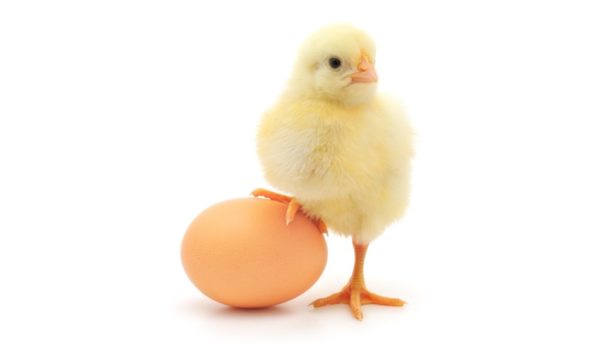
To determine weight, experts use a percentage that helps them accurately calculate the required amount. Translated into percentages, the following result is obtained: the shell weighs - 12%; yolk – 32%; protein – 56%.
Eggshells are a unique natural filter. It allows sunlight and air into the testicle and releases excess moisture and carbon dioxide back out. Therefore, in a pan of boiling water, the egg does not absorb water and does not release it. That is, the weight before and after cooking remains unchanged. But if you break the shell and fry the egg, then after cooking it will be lighter. The product will lose about 15% of its weight due to the liquid evaporated during the heat treatment process.
Shells are rarely used in cooking, so it is quite natural that buyers are interested in the question, how much do the yolks and whites weigh without shells in one individual chicken egg? The average weight of the shell is 10% of the total weight of the raw egg.
The size of an egg is influenced by many factors, the main of which are the age of the bird, its direction (egg, meat or decorative), breed and conditions of detention.
Daily intake of eggs
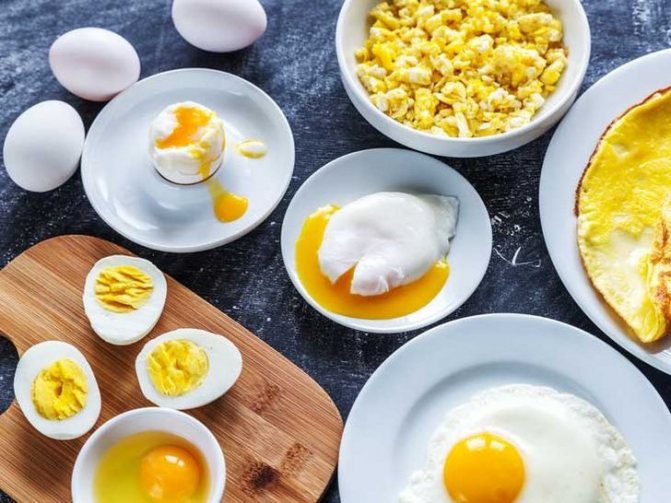
Opinions differ on this matter. American scientists urge you to eat no more than 3 eggs a week so as not to provoke an increase in cholesterol. According to other data, no more than 260 pieces should be consumed per year. (5 per week).
Most nutritionists believe that eating 1 pc. per day has a beneficial effect on health and does not cause harm. This norm is suitable for women and children, although quail is preferable for them (4-5 pieces per day), because they have a higher mineral content. For men and athletes, the quantity can be increased to 2 pcs. daily. Read more about the beneficial properties of eggs and contraindications for this product in the article.
How much does an egg white weigh?
Since the protein is the most “weighty” part of the egg, it is especially important to take into account the category when calculating its weight, because the largest selected eggs will have twice the weight of the protein compared to a product of the third category.
Accordingly, if a dish requires precise proportions, and a diet requires strict adherence to caloric intake, the error may be too large. The average weight of chicken protein is:
- 23 grams – for the third category,
- 29 grams - for the second;
- 34 grams - for the first,
- 40 grams – for choice,
- 46 grams - for the highest.
Categories of chicken eggs
There are dietary ones, which can be stored for no longer than 7 days (marked with the letter D) and table ones (C) with a more impressive shelf life. Depending on the size, according to GOST R 55502-2013, products are divided into categories:
| Category | Letter designation | Weight 1 piece, g |
| Higher | XL | 75 g or more |
| Selective | L | 65-74,9 |
| First | M | 55 to 64.9 |
| Second | S | 45-54,9 |
| Third | no designation | 35-44,9 |
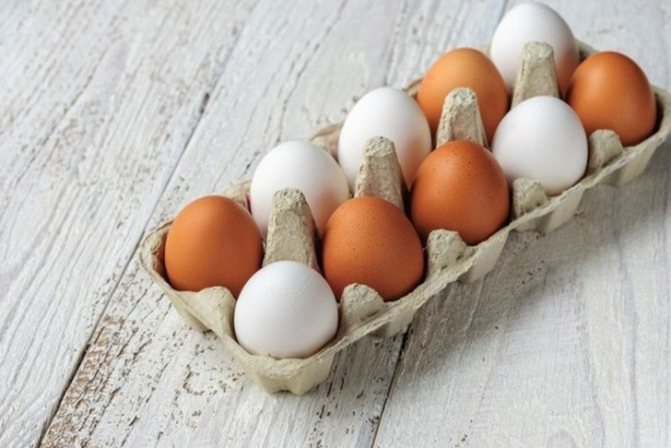
The price depends greatly on the category: the larger the product, the more expensive it is. But this has little effect on the nutritional value (the ratio of BJU and calorie content): 1 large or 2 small pieces provide the same benefits to the body.
Weight of white and yolk

The average egg in the supermarket is about 50 grams. The yolk/white ratio is 1:2. It turns out that the yolk is 17 g, the white is 33 g. That is, 1 kg = 21 eggs, 1 kg of white - 36 pieces, 1 kg of yolks - 53 pieces. Market options are larger. But even in the largest version, the average yolk weight is 25 g.
The weight of a boiled egg and the proportions remain the same as that of a raw one. It has been scientifically proven that the shell retains its contents well during cooking, so no changes occur.
Raw and cooked
When cooked, an egg does not change its mass, only if it is fried - the evaporation of moisture takes up to 15% of the mass. The weight of a raw egg remains in place during cooking, since the impenetrable armor of the shell does not release moisture anywhere and does not allow it to boil down.
Egg composition: amount of protein, fat and carbohydrates
A chicken egg contains all the vital elements, but they are unevenly distributed between its parts. The most concentrated is the yolk. It contains more proteins and fat than protein, therefore its calorie content is higher. If we take it as a whole, then this animal product is practically devoid of carbohydrates (less than 1%). It includes 13-14% proteins and 11-12% lipids, has a calorie content of 163 kcal per 100 g.
Interesting
The energy value of ostrich eggs is lower than chicken eggs and is 118 kcal per 100 g, the protein content is only slightly less - 12.2%. Although the weight of one “ostrich gift” is 1.5-2 kg.
How much does the white and yolk of one egg weigh?
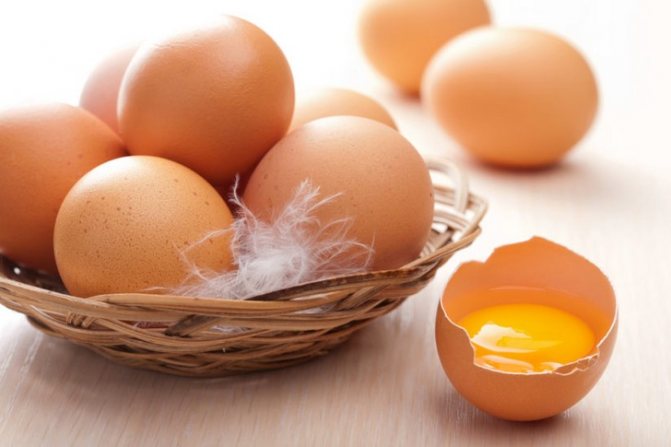
The weight of 1 piece is on average 60 g. Of this, the protein accounts for 56% or 33.6 g, the yolk accounts for 34% or 20.4 g. The exact values depend on the category of the product and, accordingly, its weight. For example:
- From 1 pc. of the highest category with a total mass of 75 g, you can get a white component of 42 g, a yellow component - 25.5 g.
- In 1 piece of the third category, weighing 35 g, the white accounts for 19.6 g, and the yolk 11.9 g.
Depending on the breed of chicken, the ratio of components varies within 1-1.5%.
How much protein is in one egg?
If we talk about the concentration of proteins in different parts of a raw egg, then the most of them are in the yolk - 17 percent. The whole product and its white part contain almost the same amount of amino acids - about 13%. At first glance, it is not entirely logical why white omelettes are more in demand on a diet. The thing is that the yolk contains a lot of fat and cholesterol, it is very high in calories. The table will tell you how many grams of protein are in one egg, as well as in its components.
Table: How much protein, fat and carbohydrates are in 1 EGG and in 100 g
| Proteins, g | Fats, g | Carbohydrates, g | Calorie content, kcal | |
| Whole, 100 g | 13,3 | 11,6 | 0,7 | 163 |
| Yolk, 100 g | 17,0 | 33,0 | 0,2 | 371 |
| Protein, 100 g | 13,0 | 0,3 | 0,7 | 54,4 |
| 1 piece weighing 60 g | 7,9 | 6,9 | 0,4 | 97,8 |
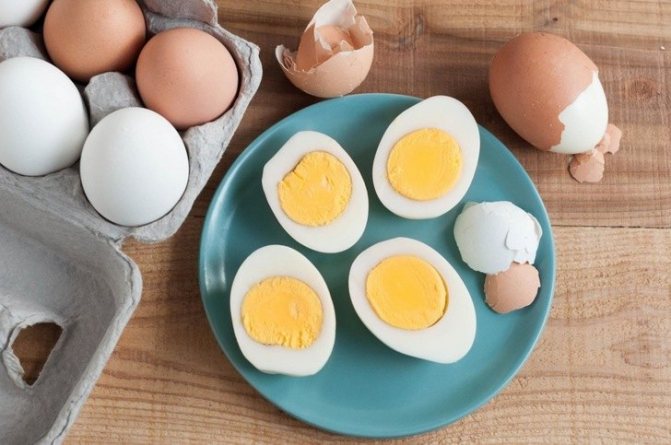
A boiled chicken egg is the best source of proteins in terms of their composition, set of amino acids, and is perfectly digestible. But in terms of concentration per 100 g, it is much inferior to other dietary products: veal, fish, shrimp, chicken breast.
The effect of heat treatment on the amount of protein
Cooking increases the absorption of animal products. Depending on the method of preparation, its chemical composition changes slightly (in terms of 100 g):
- A boiled egg contains 12.7 g of protein, and it doesn’t matter whether it’s soft-boiled or hard-boiled.
- In a fried egg without adding oil, due to the evaporation of moisture, the amino acid content will increase to 14.5 g.
- An omelet without added proteins contains 9.6 g.
- In fried eggs - 11.9 g.
The inclusion of milk, vegetables, herbs, bananas and other components in an omelet recipe greatly changes the KBJU of the dish.
Product types and categories
Before you figure out how much protein is in an egg, you need to understand what types of product exist. Often people take packaging without thinking about the subtleties - caring only about integrity. We will go further and figure out what types and categories are currently on store shelves.
Let's start with the view - there are only two of them.
- Dietary (D). The shelf life does not exceed seven days; there is a corresponding red stamp on the shell. The shell is clean, with a small number of dots, the amount of space occupied by air under the shell does not exceed 4 mm;
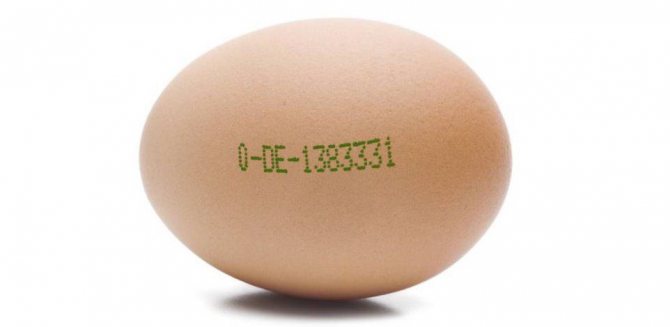
- Dining rooms (C). There is a blue stamp on the shell with the corresponding letter, the amount of empty space is from 5 to 7 mm. The shelf life reaches 25 days outside the refrigeration chamber and 90 days inside it; there may be dots and stripes on the shell (but not more than 12.5% of the total surface area).
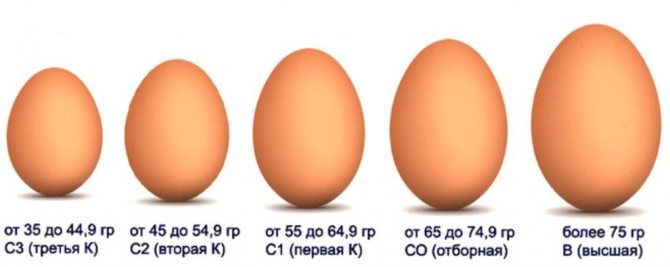
The only difference between them is the shelf life; these are not specific varieties or different products. Most often on the shelves we find a product labeled “C”. Therefore, it’s worth talking separately about possible categories! There are several of them, now you will find out all the necessary information, and then we will talk about how many grams of protein are in one egg.
We also recommend: What products does lemon balm go with?
Product category is determined by weight! Now you will find out how much protein is in an egg C0 and others:
| Category | Size | Approximate weight (in grams) | Amount of protein (in grams) |
| C3 | Little ones | 40 | 4,4 – 5,7 |
| C2 | Average | 50 | 5,7 – 7,0 |
| C1 | Large | 60 | 7,0 – 8,2 |
| C0 (Selected) | Very big | 70 | 8,2 – 9,5 |
| SV (Higher) | Huge | 75 | 9,5 – 12,7 |
Separately, you can isolate the protein in the yolk of an egg - approximately 2.5 - 3 grams! The rest of the element is contained in the protein shell.
Where is there more protein in chicken eggs or quail eggs?
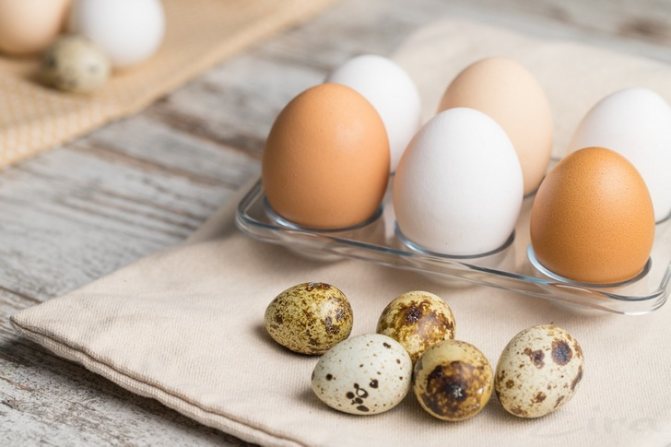
Quail eggs have their advantages: they do not contain salmonellosis, they are less likely to cause allergies, and contain more macro and microelements. But if we talk about the concentration of proteins, quail contains 11.9%, according to this indicator they are slightly inferior to chicken, they also have fewer calories (158 kcal per 100 g).
How many calories are in one chicken egg?
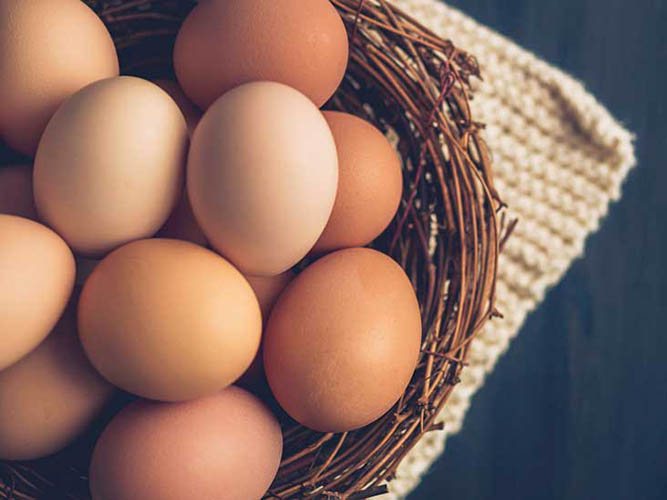
We have already figured out that eggs differ in weight, therefore, each case will have its own calorie content. Therefore, for accuracy, it is better to first find out the calorie content per 100 grams of product.
The calorie content of a chicken egg (raw) per 100 grams is 158 KCAL.
And here you can make a simple calculation: (egg weight in grams/100) * 158.
For example, let's take a 45 gram egg. Divide 45 by 100, and then multiply by 158. It turns out 71.1 kilocalories in this egg. Yes, we also took the shell into account here, but let’s take these as minor errors. 5 grams here and there won't make much of a difference.
Yes, both raw and boiled eggs have the same calorie content. But if you already make scrambled eggs, calories will be added due to the addition of oil during frying.
How long can egg whites be stored in the refrigerator?
The shell is a reliable barrier; it protects the contents from spoilage for 20 days without refrigeration. If the product is kept at a temperature of 0 to 5 degrees, then it can be consumed for 60 days. Separated egg whites are a different matter entirely. They can be stored in the refrigerator for no longer than 5 days in a closed jar. For longer storage, it is better to freeze them. True, in this case they partially lose their ability to whip into a fluffy foam.
The amount of protein in one egg is not the highest when compared to other animal products. But it is the most complete, including absolutely all essential amino acids. Because of this, steamed omelettes are allowed on all diets.
Ideal protein
Chicken eggs would not be so popular among athletes if it were only the amount of protein they contained. After all, the amount of protein in an egg does not exceed 6-7 grams , and any meat chop will surpass this figure.
But unlike chops, fish and chicken dishes, eggs also have other valuable qualities:
- maximum protein absorption;
- minimum carbohydrates and fats;
- ease of preparation.
Let's look at each item in more detail to evaluate the benefits of the product as part of a regular diet.
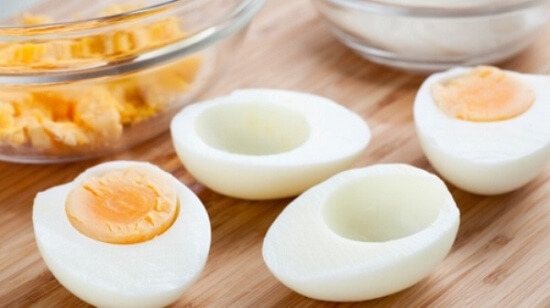
Oddly enough, instead of eggs you can sometimes use other products with similar properties. However, in this case, the product will most likely acquire the taste (as well as color, smell) of the replacement ingredient and will differ from the original.
Main replacement options:
- Thick fruit purees without sugar (banana, apple, mango, pumpkin).
Purees, like eggs, act as a binding component (they glue other ingredients together), but fruit purees do not coagulate or form a network structure. Therefore, you can replace eggs with puree only in those baked goods where, in addition to eggs, there are other ingredients responsible for the formation of the structure. This is, for example, wheat flour (biscuits, muffins, cupcakes) or cottage cheese (cheesecakes).
Please note that the fruit puree should be dense. You can buy it (but it's important to use a trusted brand, like Ravifruit) or make it yourself. To do this, simply punch the fruits with a blender and add them instead of eggs in a 1 to 1 ratio. If the dough turns out to be too liquid, you need to adjust the amount of the remaining liquid ingredients.
Also keep in mind that when replacing eggs with fruit puree, in addition to the texture, the final dessert will change:
- Taste. It will become “banana” / “apple”, etc.
- Color. The product will become darker.
- Flax seeds.
It is best to use white (golden) linen. It has a milder taste compared to brown, so it minimally affects the taste of the final product. The seeds must first be crushed using a blender or coffee grinder (1 egg = 1 tablespoon of seeds), placed in a small bowl, add water (3 tablespoons), mix and leave to swell for 30 minutes. The finished mass will resemble loose jelly.
Eggs can be replaced with other products (according to our experience and the experience of students of the Fitness (PP) desserts course), for example:
| Ingredient | Proportions | Preparation |
| Vegetable oil | 1 egg = 60 g butter | This way you can replace no more than 2 eggs |
| Tofu | 1 egg = 60 g tofu | Be sure to beat with a blender until you have a smooth, soft consistency. |
| Corn starch | 1 egg = 10-12 g starch + 20-25 g cold water | Stir until smooth |
| Peanut butter | 1 egg = 35-40 g | Stir before use |
| Chia seeds | 1 egg = 7-8 g seeds + 45 g water | Grind the seeds, add water, stir and leave for at least 15 minutes. |
| Agar-agar | 1 egg = 10 g agar + 30-40 g hot water | Stir until smooth and leave for 5-10 minutes |
| Chickpea flour | 1 egg = 20 g flour + 10 g water | Stir until smooth |
| Soy protein | 1 egg = 10 g protein + 30 g water | Stir until smooth |
| Plant-based egg substitutes, such as Bob's Red Mill or Ener-G Foods | According to manufacturer's recommendations | According to manufacturer's recommendations |
